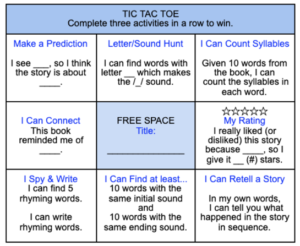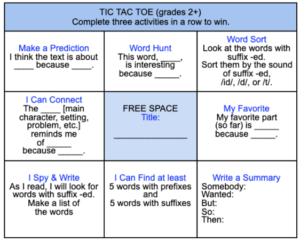CANDYLAND: To build letter-sound relationships, add individual letters or letter clusters to the CandyLand game cards. Following the game’s rules, each player takes a turn. The twist of stating the letter names and sounds correct before moving the game piece on the board will help develop fluency and automaticity in letter identification as well as letter-sound relationships. Be sure to listen for the correct articulation of the sounds, too!
CONNECT4: This engaging two-player game is easily adapted to review language skills. Using a permanent marker, like a Sharpie, write on the red and yellow game pieces. Add letters to practice letter-sound relationships, or add phonetic and high-frequency words. As an alternative to writing on the game pieces, create letter cards or word cards. Players must read (or spell) the word correctly to add a piece to the game board.
GO FISH: Do you have a house full of card players? Add words (or individual letters) to a deck of playing cards, and play go fish! Remember to ensure there are pairs or sets of 4 matching words in the deck. Elevate the rigor by mixing the new sets of 4 among the suits (diamonds, spades, clubs, and hearts). Rehearse phonemic awareness, too, by “fishing” for words that end in /d/ – which could speed up the game, too!
 HOPSCOTCH: Fresh air + physical movement + rhyming practice = WIN! Grab your sidewalk chalk or painter’s tape and draw a series of squares on your sidewalk or driveway. Any design will work, so get creative! Toss a beanbag or small rock onto the board. Given a word or syllable, the player must call out a rhyming word for each space up to the one with the beanbag & back again. For example, given the word “cat” by player 2, player 1 tosses the beanbag onto the board. It lands on #7, so player 1 jumps on #1 (hops on one foot) and says “mat.” Player 1 continues: jumps on #2/#3 (both feet) and says “sat,” hops on #4 and says “bat,” and continues up to #7. Then, player 1 turns around in square #7 while hopping on one foot, and repeats it return to the start. Additionally, players could fill the hopscotch board with words or syllables, and read the words as they hop, skip, and jump through the board.
HOPSCOTCH: Fresh air + physical movement + rhyming practice = WIN! Grab your sidewalk chalk or painter’s tape and draw a series of squares on your sidewalk or driveway. Any design will work, so get creative! Toss a beanbag or small rock onto the board. Given a word or syllable, the player must call out a rhyming word for each space up to the one with the beanbag & back again. For example, given the word “cat” by player 2, player 1 tosses the beanbag onto the board. It lands on #7, so player 1 jumps on #1 (hops on one foot) and says “mat.” Player 1 continues: jumps on #2/#3 (both feet) and says “sat,” hops on #4 and says “bat,” and continues up to #7. Then, player 1 turns around in square #7 while hopping on one foot, and repeats it return to the start. Additionally, players could fill the hopscotch board with words or syllables, and read the words as they hop, skip, and jump through the board.
I SPY: This timeless, no-cost, hands-free game is always a hit! While working on visual awareness, incorporate phonological awareness skill-building. Instead of spying a color, give clues that identify the number of syllables or the first sound in a word. For example, “I spy with my little eye something that begins with /b/.” Guesses might include (1) bark on a tree, (2) blue sky, (3) baby doll, or (4) backpack. Layering the clues could further support young players. For example, “I spy something that begins with /b/, and the word has two syllables.” The only option would be the backpack.
MEMORY MATCH: This familiar family favorite is easily recreated with paper and pen to review phonetic words, irregular (high-frequency sight) words, and vocabulary words. Beware: The marker may give away too many clues if it soaks through the paper. To prepare, cut paper into small squares or rectangles of similar size (perfection not required!). Write each of the selected review words on TWO paper pieces. Place all paper pieces face down. Players take turns flipping two-word cards in an attempt to match the words. Every pair is a point, and the player with the most points gets to choose the next game!
PICK UP STICKS: Using a handful of pencils, pens, or toothpicks, drop them onto the floor. Toothpicks could be dropped onto a cookie sheet. The goal is to pick up as many individual “sticks” one at a time and without moving any other stick. If another stick moves, the turn ends. Add in an auditory chaining activity! Each word must relate to the initial (or final sound) in the previous word. Player 1 says “bat” and picks a stick. Player 2 says “ball” and picks a stick.
SPONGE or PAINTBRUSH WRITING: Develop gross motor (large muscle, whole-body movements) and fine motor (small muscle control) skills while practicing sounds, letters, and words. Look through the craft cabinet or workbench for leftover foam sponge brushes or paintbrushes. Larger brushes are more appropriate for gross motor activities while the smaller brushes, like a watercolor paintbrush, support fine motor skill development. Using only water, children can “paint” on the patio, driveway, or sidewalk, and there are no complaints from neighbors! The best part is children of all ages can participate and rehearse appropriate skills. Strengthen auditory skills by calling out a sound as your children spell it aloud and paint it on the ground. For example, the adult says /k/, and the children say the letter name and sound as they write “c says /k/ and k says /k/.” Children can practice spelling words, too!
TIC TAC TOE: Options allow children to work at varying levels and provides flexibility for types of texts. Offer a menu of engaging activities related to reading that provide opportunities for independent and collaborative reflection. These samples highlight the incorporation of phonemic awareness, vocabulary, and comprehension skills with one text.


Playing games and incorporating foundational literacy skills can make the most of precious time at home. Setting aside time each day for intentional play can also provide structure and support focus. Remember, young learners benefit from frequent and brief lessons. Making learning multisensory and fun helps establish skills and strategies upon which future reading, writing, and spelling successes will be built. Game on!
About The Author:

Ginny Simank is a Level 4 IMSE OG Master Instructor living in Dallas, Texas. She has a master’s degree (M.Ed.) with a Reading Specialist certificate and holds certifications in special education, English as a Second Language, and generalists for Early Childhood through 6th grade & ELA 4th-8th grades. She is an IDA-certified Structured Literacy Teacher and full-time instructor for the Institute for Multi-Sensory Education (IMSE), whose mission is to train others across the country (teachers, administrators, tutors, education professionals & parents) in the Orton Gillingham methodology of multi-sensory language instruction. Ms. Simank previously served on the national board of directors for the Learning Disabilities Association and was a member of the LDA’s Education & Nominating Committees.
Sign up for our LIVE virtual Orton-Gillingham training! We are now offering half-day, evening, and weekend options to best fit your schedule.
The IMSE approach allows teachers to incorporate the five components essential to an effective reading program into their daily lessons: phonemic awareness, phonics, vocabulary, fluency, and comprehension.
The approach is based on the Orton-Gillingham methodology and focuses on explicit, direct instruction that is sequential, structured, and multi-sensory.
It is IMSE’s mission that all children must have the ability to read to fully realize their potential. We are committed to providing teachers with the knowledge and tools to prepare future minds.
